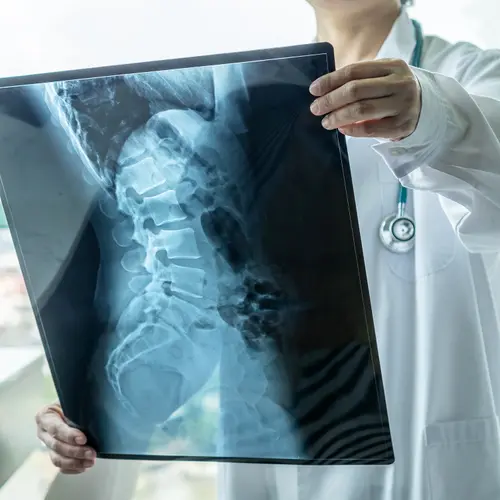Ankylosing spondylitis (AS) is an inflammatory condition that affects the spine, causing back pain and stiffness. But one-third of people with this condition have inflammation that affects other parts of the body. This can include the jaw, neck, shoulders, hips, and chest.
A common symptom of AS is chest pain or stiffness that gets worse when you take a deep breath, sneeze, cough, exercise, or put your chest in certain positions. These are signs of chest inflammation, a condition called costochondritis. This inflammation can limit how far your chest expands and cause pain when you try to breathe deeply. Chest inflammation from AS is common: It happens in 70% of cases.
How Ankylosing Spondylitis Affects Your Chest and Ribs
When the inflammation of AS reaches your chest, it can inflame the joints in your ribs to cause costochondritis. This is a harmless condition, but it’s painful. It can last for weeks and even up to a year, but it usually goes away on its own. When it doesn’t, experts call it atypical costochondritis, and you might need to go to your doctor more often to manage it.
Costochondritis can cause pain and tenderness in different parts of your chest, but you won’t see any swelling. It causes symptoms much like those of other health conditions, including slipping rib syndrome, Tietze syndrome, and fibromyalgia. Your doctor can confirm whether you have costochondritis by checking if your chest pain is due to these other medical conditions or a heart problem.
What Are the Symptoms of Costochondritis?
People with costochondritis usually have chest pain, tenderness, or stiffness. This pain can be mild, moderate, or severe. You might feel it as a dull, aching, sharp, or stabbing pain in the chest
This pain gets worse when you:
- Breathe deeply
- Cough or sneeze
- Exercise
- Place anything on your chest
- Are physically active
- Place your chest in certain positions
In rare cases, you might feel this chest pain intensely in the mornings after waking up. But it might lessen 15 minutes later.
Chest pain may also be from other causes. Seek medical help right away if you have chest pain or chest pain with any of these symptoms:
- Shortness of breath
- Heaviness or tightness in your chest
- Chest pain when you work
- Fever
- Dizziness or lightheadedness
- Nausea
- Coughing
How to Manage Chest Pain From AS
Chest pain from AS can affect your ability to do normal daily activities and cause serious discomfort. So even though it should go away on its own, it’s best to see a doctor to treat it.
Your doctor might recommend pain medication, exercise and physical therapy, or both. Available treatments can’t cure the condition, but they will help to relieve the pain and help you feel better.
Pain medication. Your doctor might recommend nonsteroidal anti-inflammatory drugs (NSAIDs) like ibuprofen and naproxen. You might be on these NSAIDs for weeks or months.
If NSAIDs aren’t the right option for you, your doctor might prescribe:
- Analgesics like acetaminophen
- Opioids (narcotics)
- Glucocorticoids (steroids) injection
- Anti-tumor necrosis factor medicines like adalimumab (Humira), golimumab(Simponi), and infliximab (Remicade)
- Anti-interleukin 17 medications likeixekizumab (Taltz) and secukinumab (Cosentyx)
- Janus kinase inhibitors like tofacitinib (Xeljanz, Xeljanz-XR)
- Antidepressants like amitriptyline (Elavil, Endep)
- Anti-seizure drugs like gabapentin (Gralise, Neurontin)
Don’t take any pain medication without first checking with your doctor. Also, try to follow your dosage correctly. Some of these medications can cause serious side effects and addiction.
Exercise and physical therapy. Exercise and physical therapy can help prevent or reduce joint stiffness and joint damage.
Your doctor might put you on a low-impact exercise program that can work on your joints without triggering your pain symptoms. Mind-body exercises like yoga or tai chi can help lower stress and ease pain.
Your doctor might refer you for physical therapy to improve pain symptoms. Your program may include:
- Stretching exercises for your chest muscles
- Nerve stimulation, a procedure that works to stop pain signals from reaching your brain
- Posture training exercises
Lifestyle changes for AS chest pain. You can take certain steps by yourself to manage your pain symptoms. Some of the ways you can lessen chest pain include:
- Limiting activities that worsen your symptoms, like high-impact or intense workouts
- Applying heat or ice pads to pain areas
- Getting rest
- Self-care activities that help you relax
- Getting therapy or joining support groups for support to help you live better with AS

